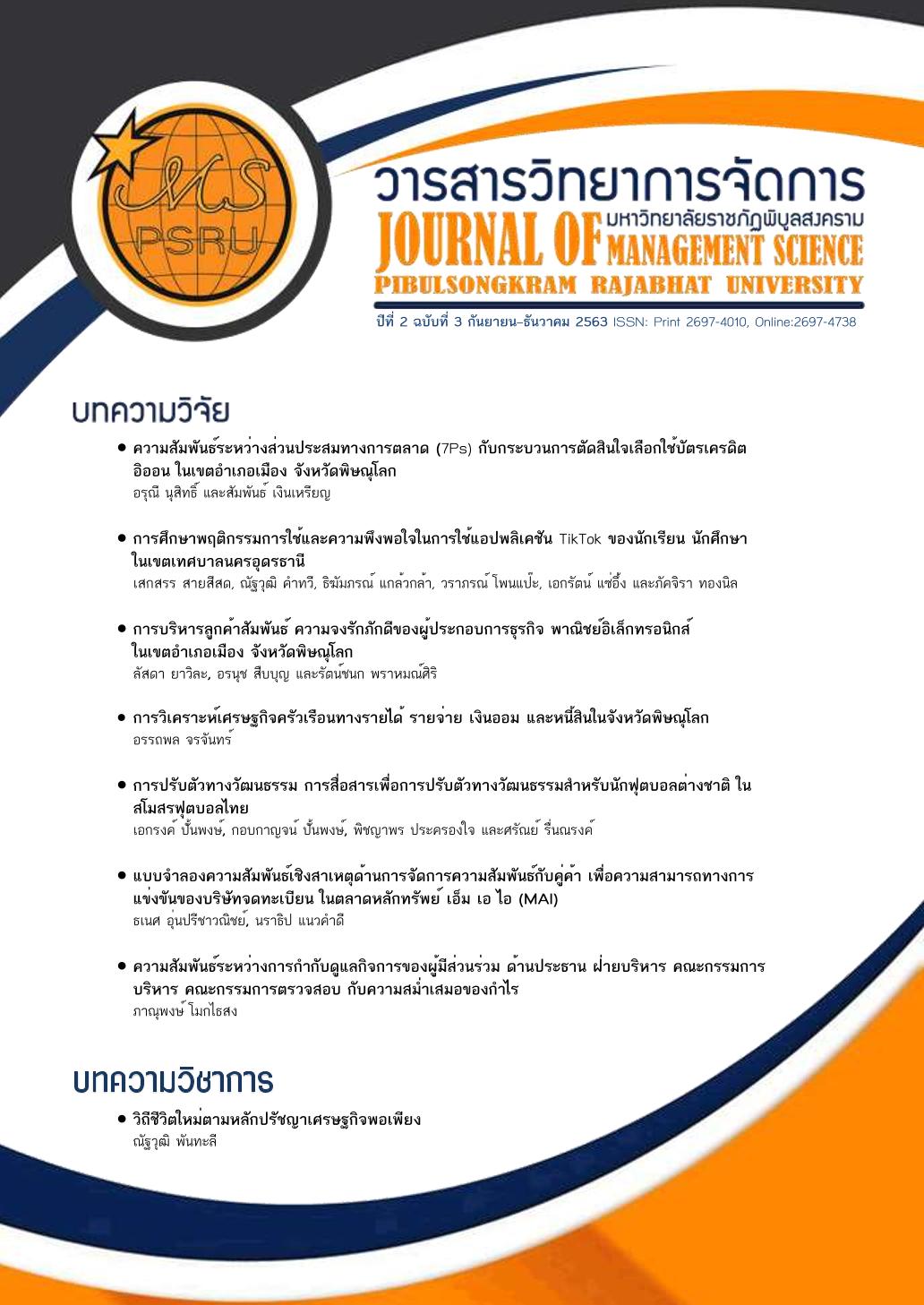การศึกษาพฤติกรรมการใช้และความพึงพอใจในการใช้ แอปพลิเคชัน TikTok ของนักเรียน นักศึกษาในเขตเทศบาลนครอุดรธานี
คำสำคัญ:
TikTok , พฤติกรรม , ความพึงพอใจ , แอปพลิเคชัน, นักเรียน, นักศึกษาบทคัดย่อ
การวิจัยครั้งนี้ มีวัตถุประสงค์ เพื่อศึกษาพฤติกรรมการใช้แอปพลิเคชัน TikTok ของนักศึกษาในเขตเทศบาลนครอุดรธานี เพื่อศึกษาความพึงพอใจพฤติกรรมการใช้แอปพลิเคชัน TikTok ของนักศึกษาในเขตเทศบาลนครอุดรธานี การวิจัยนี้เป็นการวิจัยเชิงสำรวจ จากกลุ่มตัวอย่างได้แก่ นักเรียน นักศึกษาในเขตเทศบาลนครอุดรธานี จำนวน 400 คน โดยเครื่องมือในการวิจัยได้แก่ แบบสอบถามเกี่ยวกับพฤติกรรมและความพึงพอใจ จำนวน 3 ตอน เก็บรวบรวมข้อมูลแบบออนไลน์จากนักเรียน นักศึกษาที่กำลังศึกษาอยู่ในเขตเทศบาลนครอุดรธานี นำข้อมูลที่ได้รับวิเคราะห์ด้วยโปรแกรมทางสถิติ สำหรับสถิติที่ใช้ประกอบด้วย วิเคราะห์ข้อมูลด้วยสถิติค่า ร้อยละ ค่าเฉลี่ย และค่าเบี่ยงเบนมาตรฐาน ผลการวิจัยพบว่า 1) นักเรียน นักศึกษาเพศชายที่ตอบแบบสอบถาม จำนวน 221 คน คิดเป็นร้อยละ 55.3 เพศหญิง จำนวน 179 คน คิดเป็นร้อยละ 44.7 ส่วนใหญ่มีอายุระหว่าง 22–25 ปี จำนวน 237 คน คิดเป็นร้อยละ 59.2 รองลงมามีอายุ 16–18 ปี จำนวน 42 คน คิดเป็นร้อยละ 10.5 รายได้เฉลี่ยต่อเดือนของกลุ่มตัวอย่างส่วนใหญ่ ต่ำกว่า 6,000 บาท จำนวน 206 คน คิดเป็นร้อยละ 51.5 รองลงมาอยู่ที่ 6,100–9,000 บาท จำนวน 110 คน คิดเป็นร้อยละ 27.5 ระดับการศึกษาส่วนใหญ่อยู่ที่ระดับปริญญาตรี จำนวน 305 คน คิดเป็นร้อยละ 76.3 รองลงมาอยู่ที่ระดับมัธยมศึกษาตอนปลาย 2) พฤติกรรมการใช้แอปพลิเคชัน TikTok ของนักเรียนนักศึกษาจังหวัดอุดรธานี พบว่านักเรียนนักศึกษาจะรู้จักแอพพลิเคชั่น TikTok จำนวน 390 คน คิดเป็นร้อยละ 97.4 รู้จักแอปพลิเคชัน TikTok ผ่านสื่อสังคมออนไลน์ จำนวน 384 คน คิดเป็นร้อยละ 96.1 ความถี่ในการเข้าชมต่อสัปดาห์ส่วนใหญ่อยู่ที่ บ่อยครั้ง (สัปดาห์ละ 5-6 ครั้ง) จำนวน 232 คน คิดเป็นร้อยละ 57.9 ช่วงเวลาที่เลือกชมวีดีโอ TikTok ส่วนใหญ่อยู่ที่ 20.00 – 00.00 น. จำนวน 168 คน คิดเป็นร้อยละ 46.1 ประเภทวีดีโอ TikTok ที่เลือกชมส่วนใหญ่ คือ เต้น cover dance จำนวน 253 คน คิดเป็นร้อยละ 63.2 สร้างวีดีโอ TikTok กับเพื่อน จำนวน 200 คน คิดเป็นร้อยละ 50 เหตุผลที่เลือกชมส่วนใหญ่คือ ความสนุก เพลิดเพลิน จำนวน 358 คน คิดเป็นร้อยละ 89.5 ฟังชันในแอปพลิเคชัน TikTok ที่คนส่วนใหญ่ชอบมากที่สุดคือ ติดตามครีเอเตอร์ที่ชื่นชอบ จำนวน 190 คน คิดเป็นร้อยละ 47.4 บริการในแอปพลิเคชัน TikTok ที่คนส่วนใหญ่เลือกใช้คือ มีประเภทวีดีโอให้เลือกหลากหลาย จำนวน 147 คน คิดเป็นร้อยละ 36.8 ด้านประโยชน์ของการใช้แอปพลิเคชัน TikTok ส่วนใหญ่อยู่ที่ การสร้างความสนุกสนาน ลดความตึงเครียด จำนวน 321 คน คิดเป็นร้อยละ 80.3 ด้านผลเสียของการใช้แอปพลิเคชัน TikTok ส่วนใหญ่เห็นว่าอยู่ในโลกออนไลน์มากเกินไป จำนวน 274 คิดเป็นร้อยละ 68.4 3) ความพึงพอใจในการใช้แอปพลิเคชัน TikTok ของนักเรียนนักศึกษาในเขตเทศบาลนครอุดรธานี พบว่า นักเรียน นักศึกษามีความพึงพอใจด้านเทคนิคคือ พึงพอใจต่อระบบการเผยแพร่วีดิโอ อยู่ในเกณฑ์มากมีค่าเฉลี่ย 4.30 ด้านการเผยแพร่วีดิโอ พบว่านักเรียนนักศึกษาพึงพอใจต่อคอนเทนท์ที่หลากหลายในแอปพลิเคชัน TikTok อยู่ในเกณฑ์มาก มีค่าเฉลี่ย 4.37 และด้านความพึงพอใจในการให้บริการของแอปพลิเคชัน TikTok พบว่านักเรียน นักศึกษา พึงพอใจต่อความสะดวกในการเลือกชม ที่สามารถชมได้ทั้งโทรศัพท์มือถือ หรือแท๊ปเล้ต อยู่ในเกณฑ์มาก มีค่าเฉลี่ย 4.32
References
จิณณรัตน์ ธัญศิรอนันต์. (2562). การเปิดรับสื่อ การรับรู้ ทัศนคติ การใช้ประโยชน์และความพึงพอใจต่อแอปพลิเคชัน TikTok (วิทยานิพนธ์ศิลปศาสตรมหาบัณฑิต). กรุงเทพฯ: สถาบันพัฒนบริหารศาสตร์(NIDA).
ชมพูนุท นรินทรางกูล ณ อยุธยา และประณีต ใจหนัก. (2563). ความสัมพันธ์ระหว่างโชเชียลมีเดียและการตอบสนองของผู้บริโภคในการเข้าถึงข้อมูลทางการตลาด. วารสารวิทยาการจัดการมหาวิทยาลัย ราชภัฏพิบูลสงคราม, 2(2), 11-25.
พรรณพิลาศ กุลดิลก. (2563). กลยุทธ์การสื่อสารตราสินค้าและพฤติกรรมการสื่อสารของผู้ใช้งานแอปพลิเคชัน TikTok วารสารการสื่อสารและการจัดการ นิด้า, 6(2), 35-51.
มนัสนันท์ อภิรมย์วิจิตร. (2554). ปัจจัยที่มีอิทธิพลในการเปิดรับชมรายการข่าวบันเทิงของประชาชนทั่วไป ในเขตกรุงเทพมหานคร. กรุงเทพฯ: มหาวิทยาลัยธรรมศาสตร์.
มาร์เก็ตเทียร์. (2564). Internet User ในประเทศไทย 2564 ผู้ใช้งานอินเทอร์เน็ตไทยมากแค่ไหนเมื่อเทียบ กับโลก. สืบค้น 20 พฤษภาคม 2564, จาก : https://marketeeronline.co/archives/208372.
รณิดา อัจกลับ. (2563). ความพึงพอใจและพฤติกรรมการมีส่วนร่วม Challenge ในแอปพลิเคชัน TikTok ของผู้ใช้ที่อาศัยในเขตกรุงเทพมหานคร (วิทยานิพนธ์ปริญญามหาบัณฑิต). กรุงเทพฯ: มหาวิทยาลัยกรุงเทพ.
ลักษิกา ศรีวรขันธ์ และจุฑารัตน์ โยธี. (2563). การศึกษาพฤติกรรมการใช้และความพึงพอใจจากแอปพลิเคชั่น TikTok ของนักเรียนในเขตเทศบาลนครอุดรธานี. (รายงานการวิจัย). อุดรธานี: มหาวิทยาลัยราชภัฏอุดรธานี.
Wittawin. A. (2563). TikTok คืออะไร ? ส่องเทรนด์แพลตฟอร์มที่มาแรงสุดในปี 2020. สืบค้น 3 เมษายน 2564, จาก: https://www.thumbsup.in.th/TikTok-trends-2020.
สิริชัย แสงสุวรรณ. (2558). พฤติกรรมการใช้สื่อดิจิทัลของผู้บริโภคในเขตกรุงเทพมหานคร. การค้นคว้าอิสระนิเทศศาสตรมหาบัณฑิต. กรุงเทพฯ: มหาวิทยาลัยกรุงเทพ.
สำนักงานศึกษาธิการจังหวัดอุดรธานี. (2562). ข้อมูลสารสนเทศด้านการศึกษาจังหวัดอุดรธานี ปี พ.ศ. 2562 : อุดรธานี. สืบค้น 28 มิถุนายน 2563, จาก: https://www.udonpeo.go.th/web/?page_id=5265.
อรุณี นุสิทธิ์ และสัมพันธ์ เงินเหรียญ. (2564). ความสัมพันธ์ระหว่างส่วนประสมทางการตลาด (7Ps) กับกระบวนการตัดสินใจเลือกใช้บัตรเครดิตอิออนในเขตอําเภอเมือง จังหวัดพิษณุโลก. วารสารวิทยาการจัดการมหาวิทยาลัยราชภัฏพิบูลสงคราม, 2(3), 1-10.
อินดิจิทัล. (2563). สถิติของ TikTok ที่นักการตลาดควรรู้. สืบค้น 2 กุมภาพันธ์ 2564, จาก: https://www.indigital.co.th/TikTok-stats/.
Klapper, J. T. (1960). The Effects of Communication. New York : Free Press.
Downloads
เผยแพร่แล้ว
How to Cite
ฉบับ
บท
License
บทความที่ได้รับการตีพิมพ์ในวารสารวิทยาการจัดการมหาวิทยาลัยราชภัฏพิบูลสงคราม เป็นลิขสิทธิ์ของ คณะวิทยาการจัดการ มหาวิทยาลัยราชภัฎพิบูลสงคราม บทความที่ลงพิมพ์ใน วารสารวิทยาการจัดการมหาวิทยาลัยราชภัฎพิบูลสงคราม ถือว่าเป็นความเห็นส่วนตัวของผู้เขียน คณะบรรณาธิการไม่จำเป็นต้องเห็นด้วย ผู้เขียนต้องรับผิดชอบต่อบทความของตนเอง


